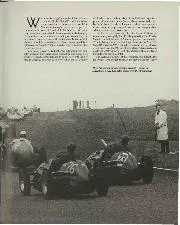Within the sport it is well known that the only cars Crombac truly cares for at Grands Prix bear the name Lotus. It is said that if you were to cut his wrists, his blood would most likely coagulate into the name. His son is named Colin lames after Chapman and Clark. He related how his faithful affair with the marque began.
“I had an English friend called All Hitchins, who had an Allard and a Cooper-MG. He was in the printing business, printing transfers for ceramics in Stoke-on-Trent. He was making a very brisk job with cities in France such as Limoges, which is the centre of French ceramics. Most of his turnover was done there so he was going every month and he thought it would be nice to race in France as often as possible, you know, on the travelling expenses from the business. He offered me to go 50/50 on buying a sportscar to share for French races. It was Hitch who said that really the car to have was the Lotus. Of course I knew about it because this was the end of ’53 and that year Colin had done a fantastic season with his Mk6 which The Motor had dubbed ‘the preposterously fast Lotus’ at Crystal Palace after he’d beaten Bob Said with the OSCA.
So he said, ‘Why don’t we buy the car?’ So I went to Lotus in October at the end of the season to buy that car. I was already working for the Autosport at that time, because I went to the British GP in ’48 to do the lap chart with Louis Chiron, and this is where I met Gregor Grant. I became friends with him, and from then on he said why didn’t I send him snippets of information to him as he was then sports editor of The Light Car. He would say that he had news from the spy Hercules, from France . . .
“And then of course, when I was working for Sommer, he turned up one day in his little Y-Type MG and told me that he was shortly starting Autosport and would I become the continental correspondent? So that gave me very good insight into the British motor racing scene. When I arrived at Lotus there was the famous story where Autosport telephoned to say, ‘Our continental correspondent is coming to buy a car from you.’ Colin had all work stopped to clean the place up, and when I arrived I was very juvenile looking and they thought, ‘Oh, that great continental correspondent couldn’t make it and he’s sent his stooge instead.’ Anyway, we became very friendly,” Crombac would later pen Chapman’s biography “and from then on, immediately after that whenever Colin wanted anything to do with the continent I became sort of his agent. Especially I had a lot of dealings to do on his behalf with Le Mans and also, unfortunately, when we had a driver killed, like Mackay Fraser or the same race at Reims where we had Jay Chamberlain injured. Later, of course, when Peter Arundell was hurt; unfortunately I was in charge when anything like that happened.”
To his eternal credit, Crombac has been able to forge such close ties with a team as later he also would with Matra without compromising his journalistic integrity.
He was also the journalist who was closest to Jimmy Clark. The two shared a flat in Paris for a time, during the Scot’s tax exile from his homeland. His assessment of the relationship’s roots is a little surprising.
“Of course, I was already close to Lotus when Jimmy came along, but there is a thing; amongst my numerous British friends of the time I was very close to Ron Flockhart, and through Ron I had a special link with Scotland. I should have raced at Charterhall, but I crashed on the way back from the circuit going a little too fast on the road. I was staying in Chirnside with the Sommervails you remember Jimmy Sommervail and Ron had arranged that. Gregor was a real Scotsman, too, of course, so I was feeling close with Scots people and that sort of got me close to Jimmy. And Jimmy knew about that. They knew that if they had a problem in Paris, they could go and see Crombac and he would sort it out.
So I immediately hit it off with Jimmy and, I don’t know, somehow we were very close. I always said that the two reasons why I got on so well with Jimmy, contrarily to some other people who certainly did more for him than I did, were one, that I never once discussed money or borrowed money from him. I had never any idea what he was doing with his money, what he was investing in, and so forth. And this is something which Jimmy really disliked to discuss. And the other thing, though I had a lot of opportunities, is that I never chased one of his girls, even if he was through with her. I had many opportunities, I can tell you, but I never chased any of his exes! I think he appreciated that.” Surprising, too, given how close was their friendship, that he never felt moved to write a biography of his friend. Once, when I asked him why he had written about cars but not drivers, he replied: “Drivers lie to you; cars don’t.
“The thing is,” he expanded recently in Hungary, “we had this little test, this discussion in the motorhome this morning. I asked a well-known French motor racing journalist: ‘Do you remember the cars racing before the war?’ And he said, ‘Yes, Mercedes, Auto Union.’ I said, ‘Who was driving them?’ And he could not remember! He had not seen them racing but he knew what they were, but he did not know who had been driving them! I said, ‘There you are. The drivers are an accessory to the car!’ “Okay, I became very friendly with Jimmy. Also with Graham. I mean, Graham had worked as a mechanic for me. He did help me when I bought my second Lotus, my Eleven. I bought it in kit, and because of my relationship with Colin he said I could build it up in the factory and they would help me. When I arrived there he assigned me a mechanic, and it was Graham Hill. I knew him already because before he was at Lotus I had seen him when he was with Dan Margulies and he drove through Paris on his way down to Morocco for a little race in Dakar. I knew Graham very well, and when it was finished and I drove it off, Graham said, Jabby, if you do the 12 Hours of Reims will you take me as a co-driver . . .
“And of course, I was very close to Jochen. I was the one who bought Jochen to Le Mans. He came in 1964 with Chinetti, who was very, very close with my partner in the French magazine that I started, Sport Auto. Jean Lucas. Jean started his career as Luigi Chinetti’s right-hand man and was his co-driver in some races. They won together the race at Spa following Le Mans in ’49, after he had won Le Mans with Lord Selsdon. So when we started Sport Auto, Chinetti helped us. He was putting advertising for his racing team on the back cover, which was bringing us a lot of money and for him, absolutely nothing.
He was always totally disorganised and he would turn up at Le Mans with a fleet of cars; he would have entered four, five, six cars. In each of them was a paying American customer, and for the rest he would come and ask me who we should put with them. I would help him pick the best available drivers. “One year he wanted a driver and I was quite friendly with Rolf Markt, an Austrian Formula Junior driver, who was very friendly with Jochen. And Markt was in my office and we were discussing Jochen and I said, ‘This fellow Rindt, I don’t know him but he really is impressive.’ And he said, ‘Yes, and he’d like to drive at Le Mans.’ I said, ‘Tell him, if he wants to drive in Le Mans I can get him a ride with Chinetti, no problem.’ So we phoned him and Jochen took the next plane. In fact I don’t think he drove that year because David Piper burst the oil filter at the start because they hadn’t warmed up the oil enough. But he had been so impressive in practice that Chinetti told him he wanted him next year and, of course, he won the race the following year with Masten Gregory.
“I had been helping Jochen quite a bit early in his career, and I was helping these guys not because they were racing drivers but because they were friends. For me, the fact that a man is a racing driver doesn’t make him a special hero. My heroes are the engineers. My heroes were Colin Chapman, Gordon Murray, Patrick Head and John Barnard, because I am more attracted by the technical side. Probably like Denis Jenkinson.”



